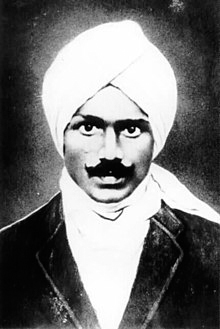Registered with the Registrar of Newspapers for India under R.N.I 53640/91
Vol. XXIX No. 7, July 16-31, 2019
Tamil Journalism – A flavour of distinct political leanings
by Mrinal Chatterjee

G. Subramania Aiyer.
Compared to many other Indian languages, journalism in the Tamil language was rather slow in growth initially. There were not many Tamil newspapers till the end of the 19th Century. The early Tamil journals were non-political and mostly promoted by missionaries who used them as vehicles for proselytising.
The first Tamil journal Tamil Patrika (1831), a monthly, was published by the Religious Tract Society. Although it had government support, it did not survive long and closed down after two years. Another journal of the period was Rajavvritti Bodhini (1885), which specialised in publishing news items translated from newspapers received from England. Dinavarihamani, its contemporary, was a weekly edited by Reverend P. Percival and published by the Dravidian Press. It had government support and was reputed to have had a circulation of 1,000 copies, which was considered large in that age.

Subramania Bharati.
A British-sponsored publication was Jana Vinodhini which captured public imagination by carrying a series on the Ramayana. It gave greater importance to literary and educational subjects than to current events and news. Viveka Vilasam appeared in 1865 and its main object was to counteract the missionaries’ propaganda. It was promoted by non-Christian Tamil scholars. Madras was the home of these journals and it was also the centre from where newspapers in several other regional languages were published. In 1876, nineteen journals were published from Madras (now Chennai) in four languages: Tamil, Telugu, Malayalam and Hindi.
The first Tamil newspaper in the real sense was the Swadesamitran which was started as a weekly in 1882 by G. Subramania Aiyer, who was also one of the founders of The Hindu. It became a daily in 1899 and dominated Tamil journalism until 1934. It was a pioneering effort for Subramania Aiyer and very soon he was equally at home in Tamil journalism and in English. The poet and patriot, Subramania Bharati entered the portals of journalism through the Swadesamitran where he served as a sub-editor for a short period.

The office of Swadesamitran, now demolished to make way for VGP House on Mount Road.
He paid this tribute to Subramania Aiyer in a letter to The Hindu from Pondicherry in December, 1914: “Unaided he (Subramania Aiyer) had made Tamil journalism a fact of the world, in spite of his very imperfect early training in Tamil literature. Learn, says the Tamil aphorist, while you are yet young. In Subramania Aiyer’s youth, he had wholly neglected his mother tongue like most people in this country who claim to have been ‘educated’ in English schools. But his mature patriotism had to realise later on, that for the elevation of the Tamil race, the Tamil language would be not only the most rational but the indispensable medium. They win who dare; Aiyer dared and he has succeeded in establishing a Tamil daily journal which, with all its faults, is the most useful newspaper in the Tamil country.”
After Subramania Aiyer, A. Rangaswami Iyengar took over the editorship of the paper. He carried out many improvements in its format and contents and made it very influential in provincial and national politics. The Swadesamitran became the mouthpiece of the Congress and it was also the Tamil version of The Hindu whose popularity and circulation it shared in fair measure.
However, the man who was its greatest editor and made it a household name was C.R. Srinivasan, who took over from Rangaswami Iyengar in 1928. His strongest weapon was his editorials in which in simple language and style, he explained to his readers political and economic issues, which until then had remained beyond the cognitive reach of large masses of Tamil readers. In his hands, the Swadesamitran proved to be both a teacher and a leader for the Tamil literates whose political consciousness was stirred by its relentless campaign for the social development and political emancipation of the country.
CRS, as he was affectionately known in journalist circles, was a brilliant commentator in English, too. His frequent contribution on men and matters appeared in The Hindu and were greatly enjoyed by its readers. The Swadesamitran declined after his passing away in 1962 and folded up some years later. It was revived under another owner but did not pick up. The old magic was gone.
In 1917, V. Kalyanasundara Mudaliar started a daily, Desabhaktan, which had a short life of three years. Its aim was to present a new and refined style in display of news, and one of its editors was the revolutionary V.V.S. Aiyer. It did not have much of an impact. Kalyanasundara Mudaliar’s weekly Navashakti, which was a political and literary magazine, was an instant success.
Another great name in Tamil journalism during the period was P. Varadarajulu Naidu, who published Tamil Nadu, a daily from Madras in 1926. It achieved significant success. Varadarajulu Naidu was a Congressman and an ardent supporter of Annie Besant’s Home Rule movement. He carried on a campaign against the Justice Party through his paper and it added to his popularity. Varadarajulu Naidu, however, began to waver in his support to the Congress from 1926 and his critics said he was leaning towards the Hindu Mahasabha.
Tamil Nadu closed down in 1930. Some enterprising Congressmen started a paper India, in 1931, but it did not make much headway. Jayabharati, a tabloid priced at 3 paise, came on the scene and had some initial success. A party newspaper started by the Justice Party was the Dravida edited by J.S. Kannappar – (Courtesy: RIND Survey, March 2019).
(To be continued next fortnight)

